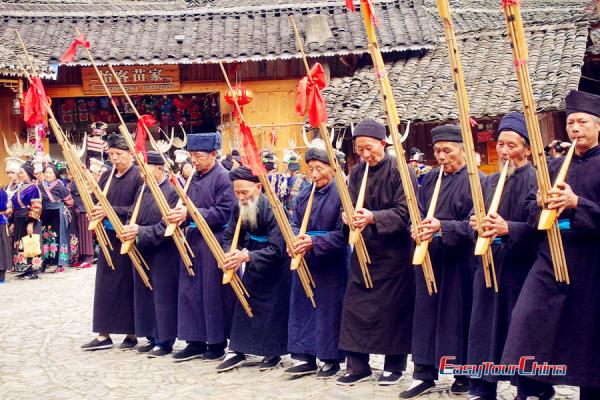Miao
As an ancient ethnic group, the Miao people are scattered all over the world, mainly in China, as well as Laos, Vietnam and Thailand in Southeast Asia.
The Miao people call themselves Hmub, Hmongb, Hmaob, Maob, and some areas call themselves ghab nus, Ghab Xongb, deb Songb. After the founding of The People's Republic of China, they are called MIAO nationality, MIAO or HMONG in English. There are "long skirt v", "short skirt Miao", "red Miao", "white Miao", "green Miao", "flower Miao" and so on.

Miao in China
The Miao ethnic minority has a population of more than 9.4 million (by 2010), mainly distributed across Guizhou, Hunan, Yunnan, Guangxi, Hubei and Guangdong provinces, forming one of the largest ethnic minorities in China. The Miao language belongs to the Miao-Yao Austronesian of the Chinese-Tibetan Phylum. They used to have their own characters which have long lost. After 1956, the Miao people invented a kind of phonetics characters. Due to their centuries of contacts with the Hans, many Miao people can also speak Chinese. The Miao people used to believe in Animism and worship their ancestors or dragons. Now some of them believe in the Catholicism or Christianity.
Recommended China ethnic tours:
11-day Guangxi & Guizhou Mountain Tribe Adventure
6-day Guizhou Miao Ethnic Sisters' Meal Festival Tour
15-day Yunnan and Guizhou Getaway Tour
Miao History
The Miao's ancestry can be traced back to the "Chiyou" tribe, a tribe in the primitive society in the Central Plains five or six thousand years ago. At that time, jiuli tribal alliance led by Chiyou appeared in the lower reaches of the Yellow River and the middle and lower reaches of the Yangtze River, and two other tribal groups headed by The Shennong clan of Yan Emperor and the Xuanyuan clan of Yellow Emperor were formed on the Loess Plateau of Gansu and Shaanxi.
Yan Emperor and Yellow Emperor developed from west to east along the Yellow River, and had a war with Chiyou in Zhuolu area. Chiyou first defeated Yan Emperor, and then Yan Emperor and Yellow Emperor combined to defeat Chiyou.
After Chiyou died, the world was in chaos. The Yellow Emperor drew a picture of Chiyou to deter the world, and the world settled down. After the defeat of Chiyou's Jiuli group, most of them migrated to the south, which started the migration history of the Miao nationality. Up to now, the legend of Chiyou has been widely spread among the Miao people, who have always believed in Chiyou as their first ancestor.
The Miao people are the earliest rice-growing people, planting rice in ancient times. In the primitive society, the Miao people took leaves as their clothes, took caves or tree nests as their homes, and took women as their leaders, which are reflected in a large number of miao ancient songs. From the system of kinship appellation in some areas, we can also see the traces of the evolution from matriarchy to patriarchy, from blood marriage to dual marriage.

After the Qin and Han dynasties, feudal dynasties established prefectures and counties in most miao areas. Miao ancestors in Wuxi area have begun to engage in agricultural production, mastered the spinning and dyeing technology of wood bark weaving and grass dyeing, and product exchange occurred.
In the Period of Wei, Jin and Southern and Northern Dynasties, the original society of the Miao nationality began to disintegrate gradually due to the continuous development of productive forces in Wuling area, and the clan commune originally composed of blood relations gradually developed into the rural commune with geographical relations.
During the Tang and Song dynasties, the Miao people gradually entered the class society, and the head of the rural commune had the right to control the land. The feudal economy of the Han nationality promoted the formation and development of the feudal Lord economy of the Miao nationality through the frequent contact between the Han and miao nationalities. Some "chieftains" became hereditary "local officials" who owned a large amount of land, and the Tusi system (native chieftain system) formed. In these areas, the Miao people became serfs (called "tian Ding"), cultivating the land of the Lord, paying rent and kimono for free labor, and had to participate in the fighting among the Lords.
Further reading:
During the Yuan and Ming dynasties, the feudal lords in the Miao regions developed economically. In the 15th year of Hongzhi (1502), the Central government of the Ming Dynasty began to implement the policy of “bureaucratization of native officers " in Chengbu Miao District of Hunan province, and other regions began to send officials. In Qing Dynasty, the government continued the policy.
Miao traditional Culture, Art & Customs
Miao Music & Dance
The Miao people are fond of singing and dancing, and have a highly-developed folk literature. Based on its content, miao folk songs can be divided into wandering song (love song), wine song, bitter song, anti-song, funeral song, labor song, political song, children's song, and riddle song, with different tunes. The love songs and wine songs are especially famous.
The lusheng is their favorite musical instrument. In addition, flutes, copper drum, mouth organs, the xiao (a vertical bamboo flute) and the suona horn are also very popular.
The Miao dance is named "Caitang" Dance, accompanied with lusheng music, hence also named "Lusheng dance".

Miao Architecture
Because timber resources are plentiful in most Miao areas, houses are usually built of wood and roofed with fir bark or tiles or are thatched. Houses vary greatly in style.
In some mountainous areas of southeast and north Guizhou, there is a special type of housing called stilted buildings. Built on a slope, the foundation is cut into an earthen platform, which is supported by long wooden columns. Animals are kept under the stilted floors.
Miao Religion
The Miao people have their own religious beliefs from a very early age. After a long history of development, the religious belief of the Miao people in different areas is different. In some miao areas, due to traffic congestion, miao people believe in primitive religion. A few miao areas, such as Weining, Shimenkan and Yuanling, xiangxi, were converted to Catholicism and Christianity in modern times under the influence of foreign missionaries. But in general, the majority of miao people still believe in the primitive religion formed by the nation for a long time, including nature worship, totem worship, ghost worship and ancestor worship.
The main nature worship objects of the Miao people are heaven, earth, sun, moon, boulders, trees, bamboo, rocks, Bridges and so on.
Miao ancestors have their own totem worship. Due to the various miao branches and wide distribution, they worship a variety of totems, such as phoenix, maple, butterfly, divine dog (panhu), dragon, bird, eagle, bamboo and so on.
Besides, the Miao people believe in ghost and sorcery. There are as many as dozens of ghosts and gods in Miao culture. They divided ghosts into good and evil spirits. They believed that good gods could bless people and should be sacrificed frequently, while evil spirits haunted people and brought misfortune, and should be expelled. Shaman is the intermediary between people and spirits, with high cultural literacy, and respected by the Miao people.
Miao Costumes
Miao people's clothing has distinctive features. Miao men usually wear linen jackets with colorful designs, and drape woolen blankets with geometric patterns over their shoulders. Miao women's clothing varies even from village to village. They have casual dress and festival outfits. Girls will be dressed up when getting married or during the important festivals and days. In west Hunan and northeast Guizhou, women wear jackets buttoned on the right and trousers, with decorations embroidered on collars, sleeves and trouser legs. In other areas, women wear high-collared short jackets and full- or half-length pleated skirts. They also wear various kinds of finely crafted silver jewelry on festive occasions.
Miao Embroidery
Embroidery is a long-established manual art of the Miao people, and the main decoration of miao people's, especially miao girls’, clothing. Miao embroidery has a variety of themes, but they are relatively fixed, including dragons, birds, fish, drums, flowers, butterflies, and pictures reflecting miao history.
Miao embroidery is very beautiful. There are 12 kinds of embroidery techniques, including flat embroidery, cross-stitch embroidery, pile embroidery, lock embroidery, pasting embroidery, seed embroidery, broken thread embroidery, nail thread embroidery, crepe embroidery, braid embroidery, wound embroidery, horsetail embroidery, tin embroidery and silk embroidery.
Miao Batik
Batik is a traditional skill passed down from generation to generation by miao people in Danzhai, Anshun and Zhijin counties of Guizhou Province. In the harsh environment of long isolation from the outside world, the miao people here gradually formed a self-sufficient lifestyle, so the ancient batik art has been preserved. According to miao customs, all women are obliged to pass on the batik technique, and every mother must teach her daughter to make batik. Therefore, miao women have learned this skill since they were young. They plant indigo and cotton, spin and weave, draw wax, dye and cut, and pass it on from generation to generation.

Miao Festivals
The Miao people have the New Year Festival, the Miao Ethnic Sisters' Meal Festival, the Flower Mountain Festival (May 5th), Miao Lusheng Festival, the Tasting New Rice Festival (between June and July), and the Tea Picking Festivals, etc.
The Miao New Year festival is celebrated on "Rabbit Day" or "Ox Day" on the lunar calendar. The festivities include beating drums, dancing to the music of a lusheng (a wind instrument), horse racing and bull-fighting. In counties near Guiyang, people dressed in their holiday best gather at the city's largest fountain on April 8 of the lunar year to play lusheng and flute and sing of the legendary hero, Yanu.
Further reading:


